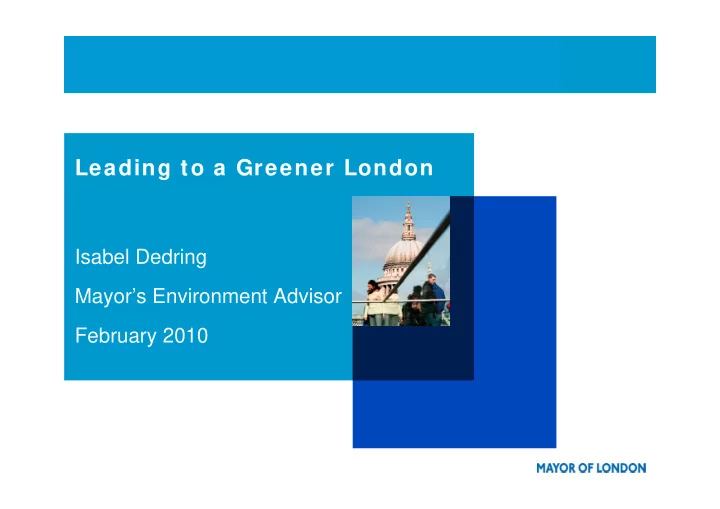

Leading to a Greener London Isabel Dedring Mayor’s Environment Advisor February 2010
2
3
Overview • A Low-Carbon London is deliverable • London can cut its footprint by 60% or 4
London’s carbon budget Profile of national targets and aspirations Profile of London’s reductions to achieve 450ppm stabilisation Profile of a BAU Projection for non-residential emissions to 2022 1 Today 50 Carbon Dioxide Emissions (MtCO 2 ) Carbon emissions 40 15% 20% 26% by 2020 CCA 2008 30 BAU* Desired national 20 profile Target for London = 60% 80% by 2050 Desired London Desired London 10 CCA 2008 profile profile 2020 2030 1990 2050 5
Other reasons • Energy context • Fuel poverty – 10% vs 25% • Air pollution – 1/3 of NO2 • Waste context – 20m (4m) tonnes, 50% landfilled • Jobs – 10-15,000 • Economic growth – £3.7b GVA 6
7
London is • Nearly 8m people • Over 3m homes • £12b energy bill each year • 27m trips a day • Over 2m registered cars • Nearly 300,000 businesses 8
4 5 m illion tonnes of CO2 Ground-based Domestic transport 38% 22% 7% 33% Industrial Commercial & public sector 9
General approach • Practical programmes that deliver • At scale and pace • Unprecedented level of resource from GLA (£100m over first 3 years) • Hassle free • Up front free • “Stop overdosing on gloom” 10
Perception vs reality Axes show 0 = least energy intensive, 100 = most energy intensive (Source: EST) 11
Potters Fields - Before
Potters Fields - After
Four w ays Mayor and GLA can act 14 14
Key program m es Building energy efficiency (75% of today’s emissions) Low-carbon energy supply (50% of the CO2 opportunity) Moving towards zero-emission transport 15
Key program m es 1. Homes programme Building energy efficiency (75% of today’s emissions) 2. Public sector buildings programme 3. Private sector engagement Low-carbon energy supply 4. Decentralised energy (50% of the CO2 opportunity) 5. ‘Banning the word waste’ 6. Supporting mode shift Moving towards zero-emission transport 7. Low-carbon vehicle technologies 8. Efficient transport operations 16
Hom es • Largest ever London homes retrofit programme • Pilots completed, 10,000 home demonstration underway • Will do 200,000 homes in next 12-18 months; target of 1.2m homes by 2015 • Just under 1 t CO2/home saved (~10-20%) • Area-based, door to door approach • ‘Man with van’ installs ’10 easy measures’ and books in for loft and cavity if appropriate • Covers water efficiency, smoke alarm, benefits check • Joint with EST, London Councils 17
Building Energy Efficiency Program m e • A cost neutral means to reduce energy bills and carbon footprint of your buildings Insulation Building management technologies • Energy service companies (ESCOs) guarantee a set level of energy savings - therefore financial saving - over a period of years • This guarantees a future income stream to fund investment in improvements Cooling equipment Low carbon heating • If all municipal buildings, schools, universities and hospitals were retrofitted, could save 1m tonnes CO2 and represents 2% of London’s CO2 emissions 18
19
20
London Tham es Gatew ay Heat Netw ork 21
W aste as a resource • ‘Banning the word waste’ • Roughly £2b of London’s £12b energy bill could be provided through energy recovery from waste • London Waste and Recycling Board: £84m over 3 years • Current performance poor • Fragmentation and planning are big challenges • Just issued Municipal Waste Strategy 22
London’s transport em issions Ground- based aviation 11% National Rail 4% Underground Three quarters of 4% emissions are from road Taxi & PHVs transport 4% Car and Bus motorcycle If everyone drove the most 5% 49% Road fuel efficient vehicle in their freight class, we would reduce car 23% emissions by 1/3 23
Transport • ‘Cycling revolution’ • Hybrid buses • LED traffic light conversion • Underground green electricity procurement • 1,000 EV’s in GLA own fleet • £20m commitment to EV rollout, including pan-London brand and charging platform starting this year • 100,000 EV’s in London by 2020 24
Adaptation • ‘100 years away’ issue? • Linking it to London’s extreme weather experiences today • Measures include –10% target for Central London –Target of 2m new trees –Green Roof Fund –Neighbourhood Flood Plans 25
New Build Zero carbon development 26
Evolution - 2013 27
Low -carbon econom y • 10-15,000 jobs; £600- 700m GVA pa; most jobs 720 14,357 845 from retrofit 832 48 Electric vehicles Commercial public buildings 847 49 (BEEP) 50 284 Residential Buildings, Basic • London USP 2,674 Waste (EfW and recycling) 52 Residential buildings 78 –financial & business services, 1,260 24 Microgeneration 44 1,675 78 –Academia Commercial buildings (BBP) 126 68 2,436 –VC, cleantech activity 62 176 Residential buildings Extra –Scale 154 3,785 142 • Olympic opportunities Decentralised Energy (CHP) 132 848 including Green GVA Jobs pa Investment (direct) pa total (£m) (£m) Enterprise District 28
How can we pay for this? • Unprecedented levels of funding, and with much greater leverage already in place • Pace, piecemeal approach and planning still huge issues • ~£60b to ‘retrofit London’ • Virtually all has commercial payback • So has to be about leverage, not about lots more public money 29
Scale 50 % of the world’s population lives in cities 75% of the world’s energy is consumed by cities 80% of the world’s GHG are emitted by cities 30
w w w .london.gov.uk 31
Recommend
More recommend